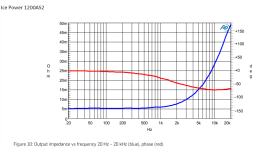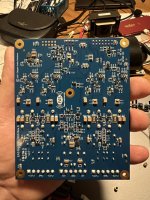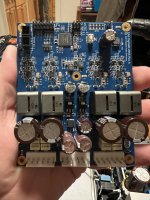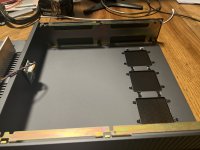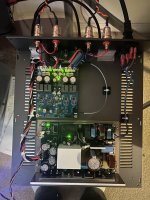Hahahaha ASR? Rotflmao assumptions without listen? Hahahahaha stop your killing me…That will depend on if it's "current starved", or "high output impedance", once someone like Amirm over at ASR does some seriouse bench tests on it, only then you can make that assumption without listening to it.
Cheers George
Not sure what your point is. But looking at measurements to see if any response anomalies are caused by high output impedance seems like a logical thing to do.
Jan
Jan
H
HAYK
This is the board I was referring to for $1250.
https://audioxpress.com/article/gan-technology-in-audio-power-amplification
https://audioxpress.com/article/gan-technology-in-audio-power-amplification
Higher switching noise low order fitering, could be a good thing seeing how much -phase shift gets down into the audio band with the usual switching frequency and filtering (red trace).Higher switching frequency translates to simpler/cheaper output filters. I think that's all there is to it.
Cheers George
Attachments
Hello everyone, I’ve been listening to this Peachtree GaN1 for a month I was curious what it would sound like in comparison to my Sun Valley S1616D amplifier that I built as a kit through my Cornwall speakers. I knew that I could bring it back if I didn’t like it, I’m not a seasoned audiophile . I bought it through eBay from Peachtree, direct as a B stock item that had a slight dent in a corner of the case, after a month of having it, and listening to it along with my tube amps I’ve decided to keep it it does sound different can play loud and clear, only when the girlfriend is not home, most of the time it’s only pulling about 15 to 18 W so it would be a good choice for someone that was living off the grid with solar panels. I’m listening to TIDAL through a blue sound node. I’m sure you would like to see what the inside of this thing looks like. I appreciate any comments I’m wondering what that white foam block on the power supply is for
Attachments
Last edited:
Thanks for showing those internals.
Just got some news there's a new intergrated one soon for the market, it's got everything. $3k
Peachtree Audio Carina GaN
https://www.peachtreeaudio.com/collections/integrated-amplifiers/products/carina-gan
Cheers George
Just got some news there's a new intergrated one soon for the market, it's got everything. $3k
Peachtree Audio Carina GaN
https://www.peachtreeaudio.com/collections/integrated-amplifiers/products/carina-gan
Cheers George
That will depend on if it's "current starved", or "high output impedance", once someone like Amirm over at ASR does some seriouse bench tests on it, only then you can make that assumption without listening to it.
Cheers George
Sorry but Amirm bench tests are mostly useless that has no meaning at all.
Nice, thanks for posting the photos.Hello everyone, I’ve been listening to this Peachtree GaN1 for a month I was curious what it would sound like in comparison to my Sun Valley S1616D amplifier that I built as a kit through my Cornwall speakers. I knew that I could bring it back if I didn’t like it, I’m not a seasoned audiophile . I bought it through eBay from Peachtree, direct as a B stock item that had a slight dent in a corner of the case, after a month of having it, and listening to it along with my tube amps I’ve decided to keep it it does sound different can play loud and clear, only when the girlfriend is not home, most of the time it’s only pulling about 15 to 18 W so it would be a good choice for someone that was living off the grid with solar panels. I’m listening to TIDAL through a blue sound node. I’m sure you would like to see what the inside of this thing looks like. I appreciate any comments I’m wondering what that white foam block on the power supply is for
The white foam is placed on top of a transformer, high voltage DC, derived straight from mains voltage, but chopped up -> at the primary; low voltage high-frequency AC at the secondary side. It could be to ensure the top plate would not touch the transformer... otherwise, it doesn't make sense to incapsulate the heat-producing thingy... care to post a photo from the side..?
It seems the amp board has 2 S/PDIF (for coax) inputs... could be useful...
The 1000uF / 6V caps I circled in yellow could be bulging... most likely due to high levels of heat dissipated from the chokes... I might be wrong, though. Anyhow, I'd check to see if they are indeed cooking.
Hmmm... on a closer look, it appears the amp board has a provision for AES/EBU digital in... With a nice DAC equipped with that balanced interface, I'd definitely use that option. Just drill the XLR-sized diameter hole at the AMP back panel. That'd be a nice improvement in sound quality.
Guess GAN systems try to get back some of the development cost. GAN is made for mass production og current hungry applications.This is the board I was referring to for $1250.
https://audioxpress.com/article/gan-technology-in-audio-power-amplification
Page 12 in the link gives an idea of the current levels where GAN really shines.
https://gansystems.com/wp-content/uploads/2022/03/GN001_An-Introduction-to-GaN-E-HEMTs_220308.pdf
Still some USB wall adapters and small motor inverters are made with GAN and they are both small and effective. So it is hope that GAN will reach mass production for audio also. Maybe mostly for active designs where there often are real volume and heat constraints?
H
HAYK
There is now a second model (Infineon maybe) GaN push pull with driver integrated besides TI LMG5200. The problem with using GaN is the driver maximum on_off time mismatch. The lowest I know is LMG1210 which is 3.4ns. If selected, typical is 1ns.
See also
See also
Last edited by a moderator:
I have wondered what is the reason audio is lagging behind with GAN implementations. This 2016 marketing blurb from EPC is very optimistic.
And in other markets they have been very succesful the last few years.
More technical 2023 blurb
https://epc-co.com/epc/gan-talk/post/23625/gallium-nitride-audio-amplifiers-the-latest-technology-in-audio--amplification
And in other markets they have been very succesful the last few years.
More technical 2023 blurb
https://epc-co.com/epc/gan-talk/post/23625/gallium-nitride-audio-amplifiers-the-latest-technology-in-audio--amplification
Last edited:
And in other markets they have been very succesful the last few years.
Yeah I bought a few shares in the supplier of the raw material for GaN production SLX (Silex) in Nov 20 for 50c and and I sold 1/2 of them in feb 23 for a very tidy profit at $5, I hope the other half now does even better.
Cheers George
Class D amplifiers are, as we all know, analogue devices. This makes analogue in analogue out with full closed loop global feedback relatively easy.
A digital in solution, that has a PCM>PWM converter, that then directly drives the output devices, is a much harder situation to wrap global feedback round. There is no analogue input signal to compare the analogue output with.
You can perform feedback, pre output filter, where you compare the PWM output of the FETs to the PWM output of the PCM>PWM converter. As far as I am aware TI have done this with some of their single chip amps. But if you want to go post output filter things then get much more complicated. As far as I know Zetex/Diodes Inc had a solution to this where they used an ADC to digitise the post filter output and perform global feedback in the digital domain.
Another solution could be to apply a low pass filter to the PWM output of the PCM>PWM converter. This would create an analogue signal that you could then compare the post filter output of the amplifier to.
To me this seems a bit like putting the horse before the cart and trying to solve problems that don't need solving. We already have fully closed loop class D amplifiers with exceptional performance from Purifi and the like. Plus we already have DACs with exceptional performance from ESS.
There's no need to try and combine the two and TI have even given up on this concept with a lot of their single chip amps. Most of them now contain a traditional DAC plus class D amplifier together in the one package.
A digital in solution, that has a PCM>PWM converter, that then directly drives the output devices, is a much harder situation to wrap global feedback round. There is no analogue input signal to compare the analogue output with.
You can perform feedback, pre output filter, where you compare the PWM output of the FETs to the PWM output of the PCM>PWM converter. As far as I am aware TI have done this with some of their single chip amps. But if you want to go post output filter things then get much more complicated. As far as I know Zetex/Diodes Inc had a solution to this where they used an ADC to digitise the post filter output and perform global feedback in the digital domain.
Another solution could be to apply a low pass filter to the PWM output of the PCM>PWM converter. This would create an analogue signal that you could then compare the post filter output of the amplifier to.
To me this seems a bit like putting the horse before the cart and trying to solve problems that don't need solving. We already have fully closed loop class D amplifiers with exceptional performance from Purifi and the like. Plus we already have DACs with exceptional performance from ESS.
There's no need to try and combine the two and TI have even given up on this concept with a lot of their single chip amps. Most of them now contain a traditional DAC plus class D amplifier together in the one package.
H
HAYK
If use GaN with very low deadtime, unlike MOSFETs, you don't need feedback at all. Here
you have 0.004% THD in open loop.
you have 0.004% THD in open loop.
Here is a solution with MCU as driver and MOSFETS but the principle with GAN (at least with integrated driver) is the same as I understand:
https://www.st.com/resource/en/appl...-32bit-arm-cortex-mcus-stmicroelectronics.pdf
With motor control they measure with motor response with ADCs and correcting as a standard solution using mixed signal MCUs. Figure 13.
https://www.st.com/resource/en/user...rones-with-stm32g431cb-stmicroelectronics.pdf
Will be interesting if we soon will see MCU - GAN solution with post filter feedback?
Again to lower amp physical volume and heat generation.
A funny moment in a TI learning video was a teacher speaking of motor drives and the signal quality from the drivers. He said they were made by the audio guys at TI: "It's like feeding caviar to a pig" The motor beeing the pig. So some of those motor drives can be used for audio.
Guess we will se that for GAN solutions also when they come to age.
https://www.st.com/resource/en/appl...-32bit-arm-cortex-mcus-stmicroelectronics.pdf
With motor control they measure with motor response with ADCs and correcting as a standard solution using mixed signal MCUs. Figure 13.
https://www.st.com/resource/en/user...rones-with-stm32g431cb-stmicroelectronics.pdf
Will be interesting if we soon will see MCU - GAN solution with post filter feedback?
Again to lower amp physical volume and heat generation.
A funny moment in a TI learning video was a teacher speaking of motor drives and the signal quality from the drivers. He said they were made by the audio guys at TI: "It's like feeding caviar to a pig" The motor beeing the pig. So some of those motor drives can be used for audio.
Guess we will se that for GAN solutions also when they come to age.
0.004% (where is this number coming from?) is far from SOTA.If use GaN with very low deadtime, unlike MOSFETs, you don't need feedback at all. Here
you have 0.004% THD in open loop.
Dead time is not the only source of distortion in class D amplifiers. Output filter should not be neglected.
H
HAYK
See post 1.
On simulator using the same GaNs in bridge with 5ns dead time it measured 0.007% with 200khz carrier.
On simulator using the same GaNs in bridge with 5ns dead time it measured 0.007% with 200khz carrier.
these output inductors alone generate plenty of distortion in open loop
Seems to me there is niche market for 'valve' sounding GaN amplifiers and that is being tapped here. Those looking for the best performance will still look elsewhere.
- Status
- Not open for further replies.
- Home
- Amplifiers
- Class D
- Peachtree new GaN-1 all "Digital Amplifier" the future?? (and it's not Class-D)
